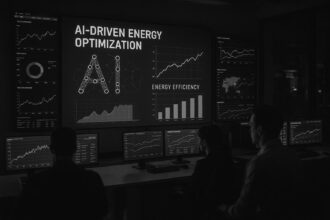Recent advancements in AI-driven tools like AlphaFold, Casanovo, and InstaNova are revolutionising protein analysis, earning Nobel recognition and enabling unprecedented discoveries across biology and archaeology.
The integration of artificial intelligence (AI) into the field of biology has reached a pivotal juncture, particularly through advancements in protein structure prediction. Tools such as AlphaFold and Casanovo are at the forefront, enabling researchers to decode the intricate world of proteins with unprecedented accuracy. For decades, scientists have grappled with understanding the 3D structures of proteins derived from their amino acid sequences—a challenge crucial for advancing drug development and disease treatment. With the launch of AlphaFold by DeepMind, this challenge has become significantly more manageable, marking a transformative moment in structural biology.
The significance of AI in biological research was underscored in 2024, when David Baker, Sir Demis Hassabis, and John Jumper were awarded the Nobel Prize in Chemistry for their pioneering work in protein research. This accolade recognises Baker’s foundational efforts in computational protein design while honouring Hassabis and Jumper for their AI breakthroughs. Their work, particularly through AlphaFold, has created an extensive database of nearly every known protein, significantly reducing the time required for biological discovery and laying the groundwork for innovations in vaccine development and therapeutic interventions for diseases.
Despite these advancements, traditional methods of protein analysis are still commonly used, often falling short. For instance, while mass spectrometry fragments proteins for analysis, about 70% of identified peptides fail to align with existing database entries. This inadequacy underscores the necessity for alternative strategies, particularly for analysing degraded or unknown biological samples. Enter Casanovo, developed by William Noble’s research team at the University of Washington. This novel approach utilises neural networks to infer likely peptide assembly, a method akin to reconstructing coherent sentences from jumbled words. By employing such advanced algorithms, researchers can delve deeper into the vast unknowns of proteomics, achieving levels of precision heretofore unattainable with older techniques.
In addition to Casanovo, the cutting-edge tool InstaNova has emerged from Europe, enhancing peptide identification through the innovative use of diffusion techniques inspired by AI image generation. By introducing calculated randomness into the data, InstaNova composes a clearer picture of the protein landscape, ultimately identifying 42% more peptides in mixed sample analyses compared to prior methods. These advancements yield vital insights into medical samples, with InstaNova+ successfully identifying 1,225 unique peptides associated with albumin, including many previously unrecognised entities. As Catrine Soiberg from Atlas Antibodies articulates, InstaNova effectively addresses the complexities of biological samples, providing researchers with actionable data that enhances analytical strategies.
The ramifications of these AI advancements extend far beyond the realm of biology and into interdisciplinary applications, including archaeology. At the University of Cambridge, researcher Matthew Collins has harnessed AI tools to analyse ancient artefacts, such as bones and ceramics, wherein proteins have undergone significant alteration over centuries. The utility of these AI models not only reshapes research methodologies but also revitalises the exploration of our historical past, elucidating connections previously obscured from view.
The ongoing evolution of AI in scientific research heralds a new era of discovery, with the potential to illuminate countless biological enigmas. AI does not simply augment existing methodologies; it challenges the very limitations traditionally imposed by time, sample integrity, and analytical precision. As these tools become more integrated into scientific inquiry, one wonders what future mysteries of biology and beyond might be unveiled.
As noted by numerous experts in the area, the fusion of AI technology with biological research not only enhances understanding but also drives forward the search for effective solutions to some of the most pressing challenges in health, environmental science, and archaeology. As AI continues to evolve, so too does the promise of unlocking even more profound insights into life itself, fundamentally reshaping the landscape of scientific inquiry.
Reference Map:
- Paragraph 1 – [1], [2], [5]
- Paragraph 2 – [2], [3], [4]
- Paragraph 3 – [1], [6]
- Paragraph 4 – [1], [2], [5]
- Paragraph 5 – [3], [6]
- Paragraph 6 – [1], [6]
- Paragraph 7 – [2], [3], [4]
Source: Noah Wire Services
- https://www.rudebaguette.com/en/2025/06/ai-finally-did-it-breakthrough-in-biology-solves-a-mystery-scientists-have-been-chasing-for-over-30-years/ – Please view link – unable to able to access data
- https://www.ft.com/content/ba14c3a1-ac8e-42b9-a5ba-9d73cc1fff4c – In 2024, David Baker, Sir Demis Hassabis, and John Jumper were awarded the Nobel Prize in Chemistry for their groundbreaking work on protein research. Baker was recognised for his pioneering efforts in computational protein design, while Hassabis and Jumper were honoured for developing AI models that predict protein structures, specifically through DeepMind’s AlphaFold. These advancements have the potential to revolutionise healthcare by accelerating the discovery and development of new therapies for challenging diseases. The prize highlights significant progress in understanding protein functions and their interactions within living cells, benefiting areas such as vaccine development, nanomaterials, and disease research. AlphaFold, in particular, has created a comprehensive database of almost every known protein, significantly shortening the timeline for biological discoveries. This marks the third announcement in the season of Nobel prizes, with literature, peace, and economics awards to follow.
- https://apnews.com/article/56f4d9e90591dfe7d9d840a8c8c9d553 – The 2024 Nobel Prize in Chemistry was awarded to David Baker, Demis Hassabis, and John Jumper for their groundbreaking techniques to decode and design new proteins using artificial intelligence (AI). Baker developed the Rosetta program to construct new proteins, while Hassabis and Jumper, from Google DeepMind, used AI to predict the structure of nearly all known proteins. Their achievements potentially revolutionise the development of medicines, vaccines, and environmentally beneficial enzymes. The winners emphasised how their AI methods have accelerated scientific discovery, a sentiment echoed by their recognition. The award also highlights the significant contributions AI can make in scientific research, with the laureates sharing half of the 11 million Swedish Kronor prize.
- https://time.com/7012710/john-jumper-2/ – For 60 years, scientists struggled with predicting the 3-dimensional structure of proteins from their 1-dimensional amino acid sequence, crucial for understanding diseases and drug design. In 2020, John Jumper and his team at Google DeepMind solved this with AlphaFold 2, a machine learning model, and made it freely available, significantly accelerating structural biology research. By 2024, they introduced AlphaFold 3, which extends predictions to other molecules like DNA and RNA, though it is not open source but available for non-commercial use. This breakthrough is fast-tracking research in various fields, from cardiovascular health to antibiotic resistance.
- https://www.lemonde.fr/en/science/article/2024/10/09/nobel-prize-for-chemistry-2024-artificial-intelligence-garners-more-recognition_6728828_10.html – The 2024 Nobel Prize for Chemistry was awarded to researchers for their revolutionary work in protein folding prediction using artificial intelligence. Half of the prize went to Demis Hassabis and John Jumper of DeepMind for developing AlphaFold, a tool that predicts the three-dimensional shapes of proteins from amino acid sequences. Their work has transformed biochemical research by significantly speeding up the process of understanding protein structures. The other half of the prize was awarded to David Baker from the University of Washington, who has made significant advancements in protein folding and synthetic protein design over the past two decades. DeepMind’s AlphaFold has provided an essential database of protein structures and their predicted shapes, which has been widely adopted in the scientific community. However, recent updates to AlphaFold’s accessibility sparked some controversy due to restricted usage guidelines. Google DeepMind has promised to release further details of AlphaFold’s latest version by the end of 2024. This Nobel Prize highlights the critical role of artificial intelligence in advancing scientific research and solving complex biochemical challenges.
- https://www.ft.com/content/9e8d9087-a71f-42a9-a7d9-c4575d05471c – Artificial Intelligence (AI) made significant strides in science, as evidenced this week when Sir Demis Hassabis, John Jumper, and David Baker won the Nobel Prize in chemistry for their work on AlphaFold, an AI software capable of predicting protein structures. This breakthrough has vast implications in medicine and biology, potentially leading to advancements in drug development and treatments for diseases like cancer and Alzheimer’s. Hassabis, the co-founder of Google DeepMind, aims to leverage AI to further tackle climate change and refine healthcare. Concurrently, Geoffrey Hinton, another AI pioneer, won the Nobel Prize in physics for his contributions to neural networks, highlighting AI’s role in modern technologies like machine learning. These awards underscore AI’s impactful role in accelerating scientific research and solving complex problems. The coexistence of AI advancements and traditional scientific methods is creating a synergy that’s pushing the boundaries of knowledge across various fields.
- https://pmc.ncbi.nlm.nih.gov/articles/PMC11292590/ – AlphaFold 3 represents a significant evolution from its predecessor, AlphaFold 2, primarily through its advanced architectural framework. The core of this new model, the Evoformer module, has been significantly enhanced to improve performance across a broader spectrum of biomolecules, extending beyond proteins to include DNA, RNA, and ligands. This architectural refinement has enabled AlphaFold 3 to achieve unprecedented accuracy in predicting drug-like interactions, setting a new benchmark in the field. The introduction of novel neural network architectures in AlphaFold 3 has been pivotal in enhancing its predictive capabilities. These innovations include a scaled-down MSA processing unit and the new “Pairformer,” which focuses solely on pair and single representations, eliminating the need for MSA representation. This simplification allows for a more focused and efficient prediction process. Additionally, the diffusion module, a new addition to AlphaFold 3, directly handles raw atom coordinates, streamlining the prediction process by eliminating the need for complex rotational adjustments.













